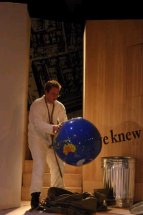|
Austrian playwright Peter Handke's blow out theatre event, the hour we knew nothing of each other, staged by the University of Rochester's International Theatre Program, is a theatrical ecstasy drawn from pithy states of being. Not an hour, as the title implies, but a two hour and fifteen minute stage travelogue, with characters who appear and disappear, without a break. Stripped of plot, the action takes place with an abundance of rapid fire exits and entrances, quick drawn characters (with 400+ costume changes), who walk, run, stumble, shuffle, crawl, sashay, and wheel in on skates, bicycles and carts; or unzip out of duffle bags and pop up out of garbage cans.
Props are the passports they took in and out like smuggled contraband. These isolated, fragmented, and wordless figures, often waiting in silence to cross unnamed borders, are stripped of everything but the sinews of their personalities. Like Alberto Giacometti's wired designs, they pass each other by wordlessly. And for Handke, a novelist as well as a playwright, being at a loss for words is a first. What to make of it?
 Well, for one thing, I suspect that director/designer Nigel Maister cleverly arranged this calliope of theatrical dynamics to give his mostly young performers a charge. If you want to make a reputation for ingenious theatre experimentation, this is the way to do it. Provide an opportunity for performers to explore quick-change character traits; the silences, the numerous rude awakenings, the compromises, the balancing acts, the sudden revelations. Characters, if you can call them that, met head on with off-the-cuff "relationships," and then left, for the next round robin of disguises. Well, for one thing, I suspect that director/designer Nigel Maister cleverly arranged this calliope of theatrical dynamics to give his mostly young performers a charge. If you want to make a reputation for ingenious theatre experimentation, this is the way to do it. Provide an opportunity for performers to explore quick-change character traits; the silences, the numerous rude awakenings, the compromises, the balancing acts, the sudden revelations. Characters, if you can call them that, met head on with off-the-cuff "relationships," and then left, for the next round robin of disguises.
If performing has something to do with learning from experience, and using what you have learned to grow into someone you have never been before, then the hour we knew nothing of each other fits the bill. Add a wall of graffiti by crook, zone & evak of fua krew, (a law firm of mad scribblers?) and the theatrical bait takes. The event was truly a happening, with a well-constructed design.
Here are a few of the telegraphic figures who emerged, disappeared, and left us to figure out who, what, where and when. For the sake of brevity, all the usual suspects, minus dozens more, in no particular order…….
a drenched figure, a bride, a watch seller, a sports fan, a solitary old man, a flight crew, someone leafing through a newspaper, women with scarves and boots, a dolly pusher, a handcuffed man, King of Spades, a woman with apples, a circus troupe, people kicking a ball, Tarzan, a man in eastern robes, Aeneas & his father, a man with snow on his hat, the shadow of an airplane flying over head with a loud roar. A man drops out of a black coat. a woman walks in risen from the dead, people burn an effigy, someone with a model of a bridge, a card player, A Jewess from Herzlia (wherever that may be), a Katrina victim, Chaplin, Puss in Boots, a woman with apples, tourists, a gardener, an old crone, a book worm. Etceteras……..
 And that's just a beginning. The etceteras followed with increasing velocity, like an airport with no flights available. Probably the most distinctive and revealing element of this parade of do unto others as you would have them to unto you, was a sense of well timed possibilities. Everyone had their entrances and exits down pat. And a certain stability occurred in the geography of shifting realities, neatly captured by a young man carrying a large rubber Rand McNally globe on stage – like Atlas. And, most intriguing, a boy pushing a small sailboat across the stage, and later sitting on a rock unfolding a map and reading in silence. Everything surrounding him imploded and gone. Innocence solidified in the wake of departed flights of fancy. A vacancy filled in a strangely absurd environment: a sign of human vulnerability. At least it had that impact for me. And that's just a beginning. The etceteras followed with increasing velocity, like an airport with no flights available. Probably the most distinctive and revealing element of this parade of do unto others as you would have them to unto you, was a sense of well timed possibilities. Everyone had their entrances and exits down pat. And a certain stability occurred in the geography of shifting realities, neatly captured by a young man carrying a large rubber Rand McNally globe on stage – like Atlas. And, most intriguing, a boy pushing a small sailboat across the stage, and later sitting on a rock unfolding a map and reading in silence. Everything surrounding him imploded and gone. Innocence solidified in the wake of departed flights of fancy. A vacancy filled in a strangely absurd environment: a sign of human vulnerability. At least it had that impact for me.
In his early work, Peter Handke used words like an incendiary alarm clock. Either jumping all over the audience in Publikumsbechpfung (Offending the Audience), or Self Accusation, an orchestrated fit of words, where a solo performer plowed through tons of guilt and disputes with himself. Directed/designer Nigel Maister used Self Accusation over speakers before the event happened. A counterpoint to the coordinates of the theatrical happening that followed. Hypnotic astonishment was the order of the day.
|